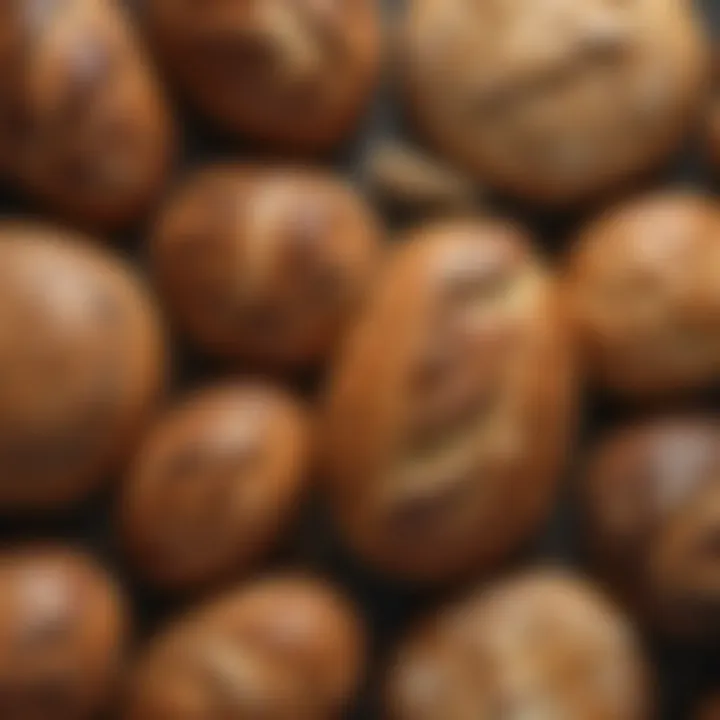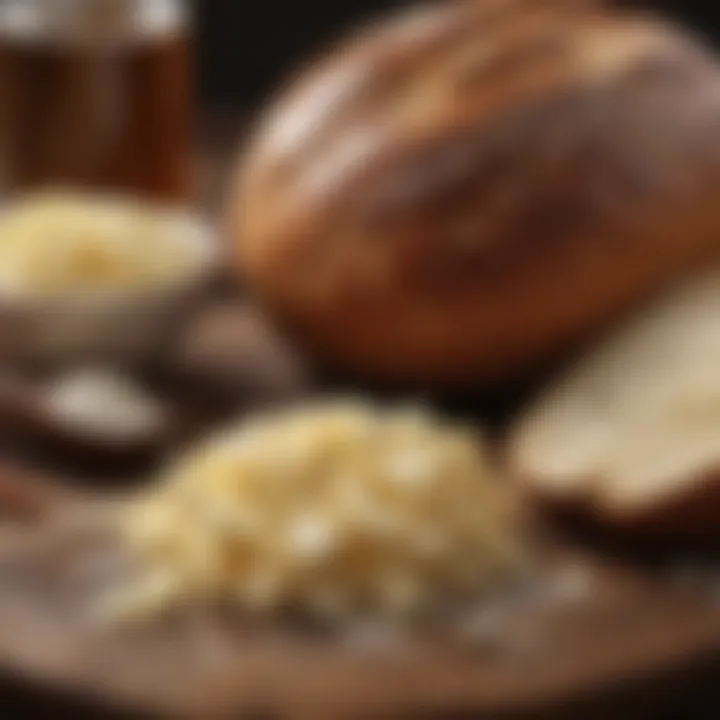Yeast Bread: A Deep Dive into Culinary Tradition


Intro
Yeast bread stands as a cornerstone of culinary tradition, bridging cultures and eras with its timeless appeal. From the rustic loaves of ancient civilizations to today’s artisanal creations, yeast bread embodies a rich history relevant to both casual bakers and professional chefs. This article aims to dissect the fundamental aspects of yeast bread, covering its historical significance, diverse varieties, and the underlying science that fuels its preparation. Throughout this exploration, we will touch upon essential ingredients and the intricate fermentation process that breathes life into dough.
The nutritional implications and cultural variations of yeast bread are equally important, providing a broader perspective on its significance in diets around the world. By delving into these topics, we not only enhance our baking skills but also cultivate an appreciation for the complexities involved in this ageless craft.
Foreword to Yeast Bread
Yeast bread has a significant place in culinary history and contemporary dining. This article will explore its intricacies, from the basic elements to its cultural influences. Understanding yeast bread offers insights into baking techniques, ingredient variations, and the science behind fermentation. Such knowledge is valuable not only for seasoned bakers but also for food enthusiasts eager to expand their culinary repertoire.
Historical Overview
The history of yeast bread is extensive and fascinating. It begins over 6,000 years ago, with the discovery of fermentation processes in ancient civilizations like Mesopotamia. Archaeological evidence suggests that the Sumerians baked a form of leavened bread. They used natural yeast found in the environment, leading to a light texture that was different from unleavened bread. Over centuries, this practice grew and spread to various cultures.
In ancient Egypt, bread-making became an art. They refined techniques, cultivating specific yeast strains. Egyptian bakers would allow dough to rise naturally, and they became the first to refine the process of kneading and proofing. Historical texts have noted that yeast bread was pivotal to religion and daily life, often featured in religious ceremonies.
As European societies developed, the tradition of yeast bread evolved. The Romans contributed to its mass production, introducing windmills and ovens. By the time of the Middle Ages, bread became a staple in various diets. Different regions began to develop unique styles of yeast breads, adapting recipes to include local flours and grains. For example, sourdough became popular in regions with specific natural yeasts.
Cultural Significance
Yeast bread holds deep cultural importance across the globe. Each region boasts different bread styles that reflect its history and community. In France, baguettes signify elegance and culinary pride, while in Italy, focaccia reflects local traditions of using oil and herbs.
In many cultures, bread is more than sustenance; it symbolizes hospitality and friendship. Breaking bread together fosters communal bonds. Festivals often celebrate the art of bread-making, inviting participation from all age groups.
Different cultures emphasize distinct practices:
- Ethiopia: Injera serves as a base for many dishes, showcasing fermentation and local grains.
- Mexico: Tortillas represent essential daily food, embodying indigenous traditions.
- India: Naan plays a central role in gatherings, often cooked in tandoors.
Overall, yeast bread embodies cultural heritage, storytelling, and culinary exploration, enriching societies where it is part of daily life.
Understanding Yeast
Yeast is the driving force behind the creation of bread that rises and takes on its characteristic texture. This section elucidates the different types of yeast available and the critical role yeast plays in the baking process. Understanding yeast allows bakers not only to create better bread but also to enjoy the science behind why bread achieves its unique qualities.
Types of Yeast
When it comes to yeast in baking, there are primarily three types that novices and experienced bakers utilize: active dry yeast, instant yeast, and fresh yeast. Each type has its own characteristics, advantages, and suitability for various recipes.
- Active Dry Yeast: This type is prevalent and widely available. It comes in granulated form and must be dissolved in warm water before use. This step activates the yeast, rehydrating it and enabling fermentation.
- Instant Yeast: Also known as rapid-rise yeast, this type is formulated to act quickly. It can be mixed directly with flour, which saves time during preparation. Many bakers favor it for its convenience and efficiency.
- Fresh Yeast: This is less common but can be found in specialty stores. Fresh yeast is a live product that needs refrigeration. It has a shorter shelf life compared to the dry varieties. Its flavor tends to be richer, making it a choice for some artisan bakers.
Each type has its context in baking, and familiarity with them can be important. Transitioning from one to another may require some adjustments in water temperature or fermentation time.
The Role of Yeast in Baking
Yeast plays a transformative role in bread making, primarily through fermentation. When yeast consumes sugars present in the dough, it produces carbon dioxide and alcohol in a process known as fermentation. This carbon dioxide gas creates bubbles, causing the dough to rise and develop its airy structure.
Additionally, yeast contributes to the flavor profile of the bread. As it ferments, various compounds develop, leading to the complexity of taste that distinguishes good bread from great bread. Understanding this fermentation process opens a door to manipulation of flavors and textures, allowing bakers to fine-tune their products.
The importance of yeast is not just in its ability to leaven bread, but in the overall enhancement of flavor and texture.
Key Ingredients in Yeast Bread
Key ingredients form the backbone of any yeast bread. Understanding these components helps in crafting not only tasty but also well-textured and properly risen loaves. Each ingredient serves a specific purpose, contributing to the flavor, texture, and nutritional profile of the final product.
Flour Variations


Different types of flour produce distinct results in bread making. The choice of flour affects not only flavor but also texture and structure.
- All-Purpose Flour: This is the most common flour. It has moderate protein content, making it suitable for a variety of breads.
- Bread Flour: This flour contains higher protein levels, usually around 12-14%. The extra gluten formed during kneading creates a chewier texture that is often desired in yeasted bread.
- Whole Wheat Flour: Whole wheat flour incorporates the entire wheat kernel. It offers a nutty flavor and higher fiber content but requires adjustments in hydration and gluten development due to its density.
- Specialty Flours: Options like rye flour or spelt can be incorporated for unique flavors. They may require more moisture and longer fermentation times.
Hydration Levels
Hydration plays a critical role in yeast bread. The ratio of water to flour dictates dough consistency and influences other aspects of bread making.
- Low Hydration (40-50%): Produces denser breads. Used for bread types like bagels, these need extra effort to knead and shape.
- Moderate Hydration (60-70%): Most common for home baking. This level balances ease of handling with good texture. It helps achieve a light crumb and even rise.
- High Hydration (80% and above): Results in an open crumb. Common in artisan styles with a crisp crust.
Managing hydration requires consideration. Flour absorbs moisture differently based on its type and age, therefore adjusting water accordingly is crucial for achieving the desired bread texture.
Additional Ingredients
Besides flour and water, many bakers add further ingredients to enhance flavor and texture.
- Yeast: The leavening agent. Options include active dry yeast and fresh yeast. Each type has its specifics based on fermentation speed and usage.
- Sugar: Enhances flavor and can feed the yeast. A little sugar fosters a quicker rise.
- Salt: Essential for flavor. It also helps control yeast activity and strengthens gluten structure.
- Fats: Ingredients like butter or oils improve texture and shelf life. They provide a softer crumb and richer flavor.
- Add-ins: Seeds, nuts, herbs, and spices can provide unique textures and flavors.
Each ingredient interacts in a complex way, affecting the overall outcome. Discernment in ingredient choices is paramount for making quality yeast bread.
“Understanding the role of each ingredient allows for better control and creativity in bread baking.”
For those looking to delve into this craft, knowing the properties of these essential components is a crucial first step.
The Science of Fermentation
Fermentation is a crucial process in the making of yeast bread. It is the act of converting sugars into carbon dioxide and alcohol with the help of yeast. This process is what gives bread its rise and texture. Understanding the science behind fermentation not only enhances the baking process but also provides insights into the cultural and nutritional aspects of bread. To appreciate yeast bread fully, a closer look at what happens during fermentation is essential, as well as the influence of temperature on this process.
What Happens During Fermentation
During fermentation, yeast consumes sugars present in the dough. This action converts these sugars into carbon dioxide gas and alcohol. The gas gets trapped in the elastic structure of the dough, causing it to rise. The alcohol produced evaporates during baking but contributes to the complex flavors that characterize many breads.
This process is that of a natural leavening agent, unlike chemical methods that often yield less rich flavors. Factors impacting fermentation can include the type of yeast used, the sugar concentration, and the dough’s hydration level. Healthy fermentation enhances the bread's texture and adds to its taste, creating a delightful eating experience.
Moreover, beneficial acids formed during fermentation contribute to the overall health benefits of the bread, including improved digestibility.
Temperature and Its Impact
Temperature plays a pivotal role in fermentation. Each type of yeast has an optimal temperature range, usually between 75°F to 85°F (24°C to 29°C), where it performs most effectively. At lower temperatures, yeast activity slows down, which can lead to extended fermentation times—this is not always a disadvantage, as slower fermentation can enhance flavor development. However, if the temperature goes beyond the yeast's tolerance, it can become inactive, halting the fermentation process entirely.
Equally, too much heat can kill the yeast, which results in dense bread without the desirable rise.
In summary, managing temperature is vital for achieving the desired characteristics in yeast bread. It requires careful monitoring to ensure that fermentation occurs as intended. Baking often becomes an intricate dance of balancing time, temperature, and ingredients to achieve the perfect loaf.
Techniques for Making Yeast Bread
The techniques for making yeast bread are crucial in the baking process. These methods determine the texture, flavor, and overall quality of the bread. Understanding these techniques allows bakers to control their results better and craft bread that meets their preferences. Two primary techniques cover significant aspects of yeast bread preparation. These are kneading methods and proofing techniques.
Kneading Methods
Kneading is the process of working dough to develop gluten. Gluten is vital for the structure of the bread. Proper kneading creates a network that traps gases released by yeast during fermentation. This helps the dough rise and results in a chewy texture.
There are several kneading methods, including:
- Traditional Kneading: This involves folding and pressing the dough with hands. The general rule is to knead for about 10 minutes. This method provides bakers with a tactile feel for the dough's development.
- Stretch and Fold: A gentler method where the dough is stretched and folded over itself instead of agitating. It is beneficial for high-hydration doughs. This helps maintain the structure without overworking the gluten.
- Machine Kneading: Using a stand mixer with a dough hook can speed up the process. It is essential to monitor the dough closely to avoid over-kneading, which could lead to a tough product.
Choosing the right method depends on the dough type and personal preferences. Traditional kneading offers control, while machine kneading provides efficiency. Ultimately, the goal is to achieve a smooth and elastic dough.
Proofing Techniques
Proofing is the period where the dough rests and rises before baking. This phase is essential for flavor development and texture. During proofing, the yeast ferments sugars in the flour, producing carbon dioxide and alcohol. Both contribute to the bread's characteristics.
There are common proofing techniques, including:


- Bulk Fermentation: This initial rise allows the dough to expand, usually lasting one to two hours. It can be done at room temperature or in a cooler environment to enhance flavor development.
- Final Proofing: After shaping the dough, this final rise typically lasts 30 minutes to an hour. It prepares the dough for baking, ensuring it will expand properly in the oven.
- Cold Proofing: Involves placing the dough in the refrigerator for an extended period. Cold temperatures slow fermentation, resulting in more complex flavors. This method is often used for artisan breads.
When proofing, it is vital to monitor conditions. Temperature and humidity play significant roles in the speed of fermentation. A warm, humid environment speeds up proofing, while a cooler setting slows it down.
Proper kneading and proofing lead to better bread results, enhancing both texture and flavor.
Common Yeast Bread Recipes
Common yeast bread recipes are fundamental to understanding the art of baking. These recipes serve as a foundation for both novice and experienced bakers, allowing them to grasp essential techniques and flavor profiles. Each recipe reflects cultural influences, ingredient choices, and baking methods that vary globally. The significance of these recipes lies in their versatility, supporting bakers in creating a wide range of delicious products.
A solid grasp of basic recipes enhances one’s ability to tweak formulas and experiment with flavors. This is crucial for anyone interested in becoming a skilled baker. Moreover, mastering these core recipes helps demystify the fermentation process and the role of yeast, improving one’s overall baking acumen.
Basic White Bread
Basic white bread is often regarded as the archetype of yeast dough. It is simple yet rewarding, making it an excellent starting point for beginners. The traditional formula includes all-purpose flour, water, salt, and yeast. This simplicity allows the yeast to develop flavor, while the gluten formed by kneading provides structure.
The process typically involves:
- Mixing the ingredients until a shaggy dough forms.
- Kneading for approximately 8-10 minutes until smooth.
- Allowing the dough to rise until it doubles in size.
- Shaping and performing a second rise before baking.
This recipe is not only basic in technique but also provides various opportunities for personalization. Adding herbs, cheese, or even spices can transform a standard loaf into something special. White bread remains a beginner's favorite due to its forgiving nature and adaptability.
Whole Wheat Bread
Whole wheat bread epitomizes a more health-conscious approach to baking. Utilizing whole wheat flour, this recipe retains the bran and germ of the grain, resulting in increased fiber and nutrients. While the process is akin to basic white bread, kneading requires greater care due to the denser flour.
A typical whole wheat bread recipe requires:
- Whole wheat flour, water, salt, yeast, and possibly honey or other sweeteners.
- Consideration of the hydration level; whole wheat flour often needs more water than all-purpose flour.
Due to its richness in dietary fiber, whole wheat bread can enhance digestive health and provide a more satiating and nourishing option. However, it demands precise measurement and attention during fermentation to ensure success. Mastering this recipe also allows bakers to explore higher fiber options without sacrificing flavor.
Artisan Breads
Artisan breads present a canvas for creativity in baking. More complex than the previous types, artisan breads often feature unique ingredients and methods, emphasizing the hands-on nature of bread making. These breads can include sourdough, ciabatta, or focaccia, each demanding its own technique and skill set.
A few hallmarks include:
- Longer fermentation times, allowing flavors to develop.
- Use of pre-ferments such as biga or poolish.
- Varied flour types and hydration levels that contribute to outstanding crust and crumb texture.
Artisan bread reflects the baker’s personality and culinary perspective. Exploring artisan techniques enriches one’s knowledge of fermentation science while cultivating patience and skillfulness.
"Baking artisan bread requires both time and care, leading to rewards that are hard to match."
Troubleshooting Yeast Bread
Baking yeast bread can be a rewarding experience, but it does not come without challenges. Troubleshooting yeast bread is essential for anyone hoping to perfect their baking skills. Problems may arise at any stage of the process, from mixing to baking. Understanding common issues can help bakers avoid failures and achieve the desired texture and flavor in their loaves. By learning how to identify and correct these common problems, bakers can save time, ingredients, and frustration, ultimately improving their results.
Common Problems and Solutions
Bakers may face several issues while making yeast bread. These problems can often be addressed with simple adjustments or changes in technique. Here are some frequent concerns:
- Poor Rising: Bread that does not rise adequately may indicate issues with yeast activation. Ensure that the yeast is fresh and that the water temperature is appropriate—not too hot or too cold. If the dough feels dense, try adding a bit more moisture to help yeast activity.
- Dense Texture: A loaf that is too dense might be a result of underkneading or improper flour measurement. Knead the dough until it is smooth and elastic. Additionally, consider using a kitchen scale for accurate measurements.
- Crust Issues: If the crust of the bread is too thick or too soft, it might be linked to oven temperature or baking time. Adjust your oven’s temperature to ensure even baking, and monitor the bread closely as it nears the end of its baking time.
"Adjusting temperature and technique can make significant differences in bread quality."


- Flavor Deficits: The flavor of the bread can be affected by insufficient fermentation time. Allow the dough more time to rise, which develops flavors through fermentation.
Adjusting for Altitude and Humidity
Baking at higher altitudes or in very humid conditions requires special considerations. Air pressure and moisture content can affect yeast behavior and dough consistency. Here are a few strategies for successful baking under these conditions:
- Higher Altitude Adjustments: At higher altitudes, reduce the amount of yeast and sugar. Also, increase the liquid content slightly, as dough tends to dry out faster. Finally, ensure the dough is kneaded well, as it may need more structure to rise properly.
- Humidity Considerations: In high humidity, flour may absorb more moisture than usual. Adjust flour quantities by starting with less and adding as needed. This adjustment helps manage stickiness and dough development.
Understanding these factors enables bakers to adapt their methods and find success in their yeast bread endeavors. With patience and practice, anyone can overcome these common challenges.
Nutritional Aspects of Yeast Bread
Understanding the nutritional aspects of yeast bread is essential as it bridges culinary artistry with health. Bread has been a staple food across cultures, and its nutrients can significantly influence dietary habits. Nutritional values vary widely depending on ingredients used. Different flours, seeds, and grains all contribute distinctively to the overall nutrient profile of the baked product. Keeping these elements in mind is important for those seeking not only to enjoy yeast bread but also to make informed choices about their food consumption.
Understanding Macronutrients
Macronutrients are the body’s main energy sources, comprising carbohydrates, proteins, and fats. In yeast bread, carbohydrates are the predominant nutrient. They provide energy required for daily activities. Sourcing these carbohydrates from whole grain flours can further enrich the bread’s nutritional content. Whole wheat flour has a higher fiber content compared to refined flour, which can enhance digestive health and improve insulin sensitivity.
Bread also contributes proteins. While it is not a complete protein source, when combined with other foods like butter or cheese, it can complement dietary needs effectively. Fats in bread can be minimal, depending on the recipe. Certain specialty breads may include healthy fats from sources like olive oil or seeds, which promote heart health.
Fiber and Whole Grains
Fiber is an essential component for maintaining healthy digestion. Whole grain breads, such as whole wheat or rye, are particularly high in dietary fiber. Incorporating these types of bread can aid in reaching the recommended daily intake of fiber, which benefits gut health and may reduce the risk of chronic diseases.
Whole grains also contain vital vitamins and minerals. These include B vitamins, iron, and magnesium, which play crucial roles in energy metabolism and overall bodily functions. Choosing yeast breads made from whole grains supports better nutrition and can lead to a sensation of satiety, helping control appetite.
"Whole grain bread can be a valuable addition to a balanced diet, providing essential nutrients while being satisfying and delicious."
The Future of Yeast Bread
The future of yeast bread is an area of considerable interest for both bakers and consumers. It encompasses not only advancements in baking techniques and technologies but also addresses pressing sustainability concerns. As the global population continues to grow, so does the demand for food production, including bread. Understanding the trajectory of yeast bread involves exploring innovations that enhance production efficiency while maintaining quality and flavor. Furthermore, with an increasing awareness of environmental issues, the future of yeast bread must also consider how to minimize its ecological footprint.
Innovations in Bread Making
Recent years have seen a surge in innovation in the bread-making industry. These innovations aim to improve the baking process, enhance nutritional profiles, and give bakers more control over their products.
- Automated Baking Systems: Many commercial bakeries are adopting automated systems. These systems ensure consistency in texture and taste while reducing labor costs.
- Smart Fermentation Technology: The integration of smart technology enables precise control of fermentation. Monitoring yeast activity can lead to improved texture and flavor.
- Alternative Flours: Bakers are exploring flours beyond traditional wheat. These include almond, chickpea, and even insect-based flours, which have unique flavors and nutritional profiles.
- Prebiotic and Probiotic Additives: Adding these components can boost gut health. They create a more complex flavor and enhance the bread's overall health benefits.
These advancements contribute to a dynamic industry that responds to shifting consumer preferences and scientific discoveries. The combination of tradition and innovation ensures that yeast bread continues to evolve.
Sustainability Concerns
Sustainability has become a vital focus in food production, and yeast bread is no exception. The bread-making process carries environmental implications, and efforts are underway to address these concerns.
- Resource Management: Sustainable practices in sourcing ingredients are becoming more common. This includes using organic grains and supporting local farmers, which can help reduce the carbon footprint associated with transportation.
- Waste Reduction: Bakeries are finding innovative ways to reduce waste. Products that use imperfect ingredients or day-old bread for new recipes help minimize waste.
- Packaging Innovations: Many brands now look to eco-friendly packaging solutions. This shift is essential to reduce plastic usage and promote recyclable materials.
Efforts to align baking practices with sustainability goals are necessary. Both consumers and producers share a responsibility to consider the impact yeast bread has on the environment.
Addressing sustainability is not just a trend; it is imperative for the survival of our planet and the food systems we depend on.
Finale
In this exploration of yeast bread, we have uncovered the various dimensions that make up this cherished culinary craft. The significance of yeast bread extends beyond just taste; it reflects a rich history and diverse cultures around the world. As we wrapped up our discussion, it is essential to reiterate certain aspects that contribute to the understanding and appreciation of this timeless craft.
Yeast bread plays a critical role in fostering community connections. According to culinary traditions, it is often at the core of various cultural celebrations, from religious ceremonies to family gatherings. Making bread can also be a communal act, where families and friends come together to share the process and, ultimately, the delicious results.
The intricate dance of science behind yeast fermentation demonstrates the wonders of cooking. Understanding the function of yeast and the reactions involved in bread making enhances one’s skillset in the kitchen. It allows aspiring bakers to troubleshoot issues that may arise during the baking process, ensuring that the loaves produced are both delicious and comforting.
Moreover, nutritional considerations cannot be overlooked. Different types of flour and ingredients provide varying levels of macronutrients and fiber, significantly affecting health. Emphasizing whole grains in yeast bread can contribute to a more balanced diet, which is an important element of modern culinary practices.
The future of yeast bread is also bright, with innovations paving the way for sustainability in bread making. As consumers become more health-conscious and environmentally aware, the demand for better quality and responsibly produced bread will continue to rise. This evolution portrays yeast bread as not only a staple but also a symbol of progress in the culinary landscape.
In summary, yeast bread holds a multifaceted place in our lives. Its historical roots, the science of its making, cultural significance, and nutritional concerns make it a poignant topic worth exploring. By engaging with this craft, we not only nourish our bodies but also connect with our past and community. This comprehensive understanding invites readers to delve deeper into the world of yeast bread, encouraging the appreciation of its enduring legacy.















